Design Exercise
Brief
Robo-investing is an amazing innovation but many consumers are scared. They are scared to have their money managed by an algorithm. What are some ways we can ease our scared consumers minds?
Deliverables
- • Please propose a design strategy for this project.
- • Design an experience for onboarding new investors. Provide your overall process, wireframes to support the user journey and one to two high-fidelity mocks.
- • Describe and wireframe some things we could do or test in order to build an engaged community of users around this product?
Problem Discovery
Gathered Context
To start, I began gathering simple yet fundamental context on what we are building. This allowed me to frame high-level goals and to adapt my design process to this particular problem.
The goal of this stage was to identify problems and opportunities so that I could narrow my focus and create value.
The goal of this stage was to identify problems and opportunities so that I could narrow my focus and create value.
Researched the market and its customers
With some fundamental context on what we’re building, I started conducting research regarding the existing market and its customers, experts’ future predictions, enthusiasts’ opinions, etc.
I wanted to find out who uses ‘robo-investor’ services and what their thoughts were.
Aware of the time and resource constraints of this design task, I decided to look for publicly-available data sources including articles, consumer surveys, case studies, and research studies.
I wanted to find out who uses ‘robo-investor’ services and what their thoughts were.
Aware of the time and resource constraints of this design task, I decided to look for publicly-available data sources including articles, consumer surveys, case studies, and research studies.
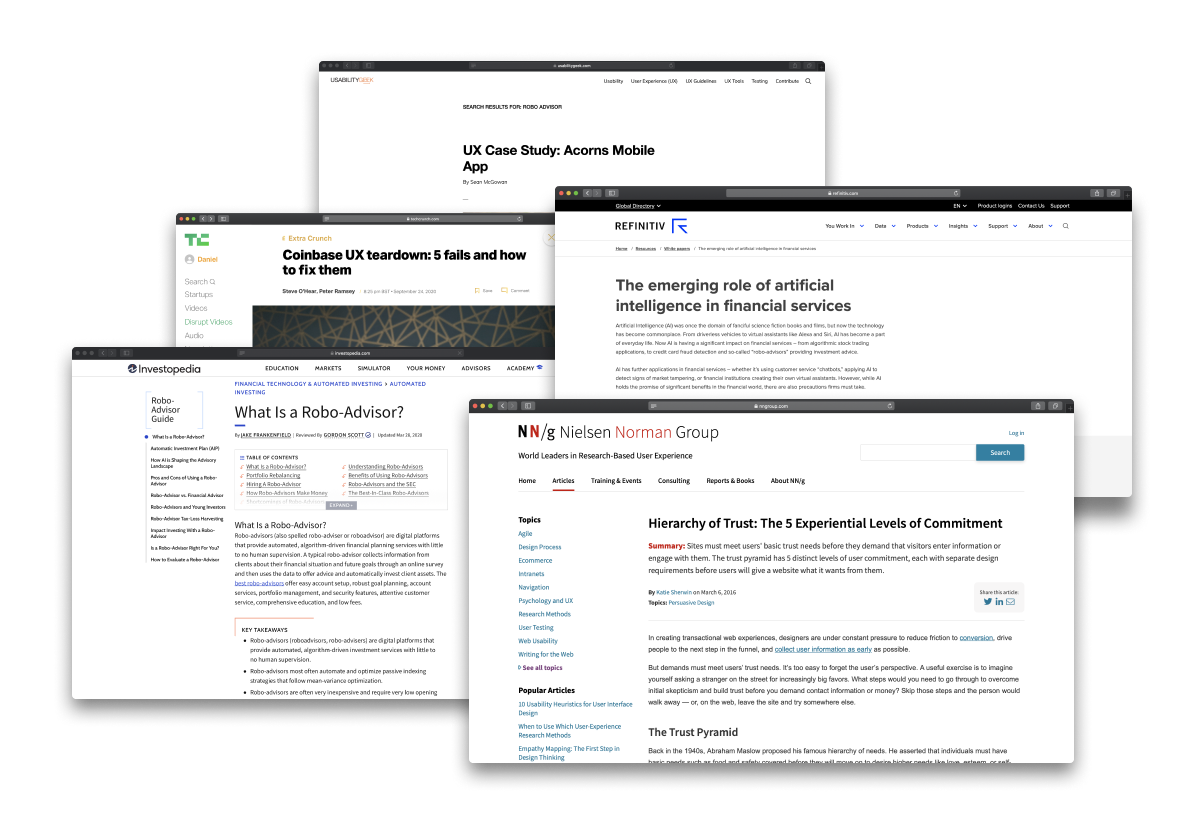
Various data sources from the problem discovery phase.
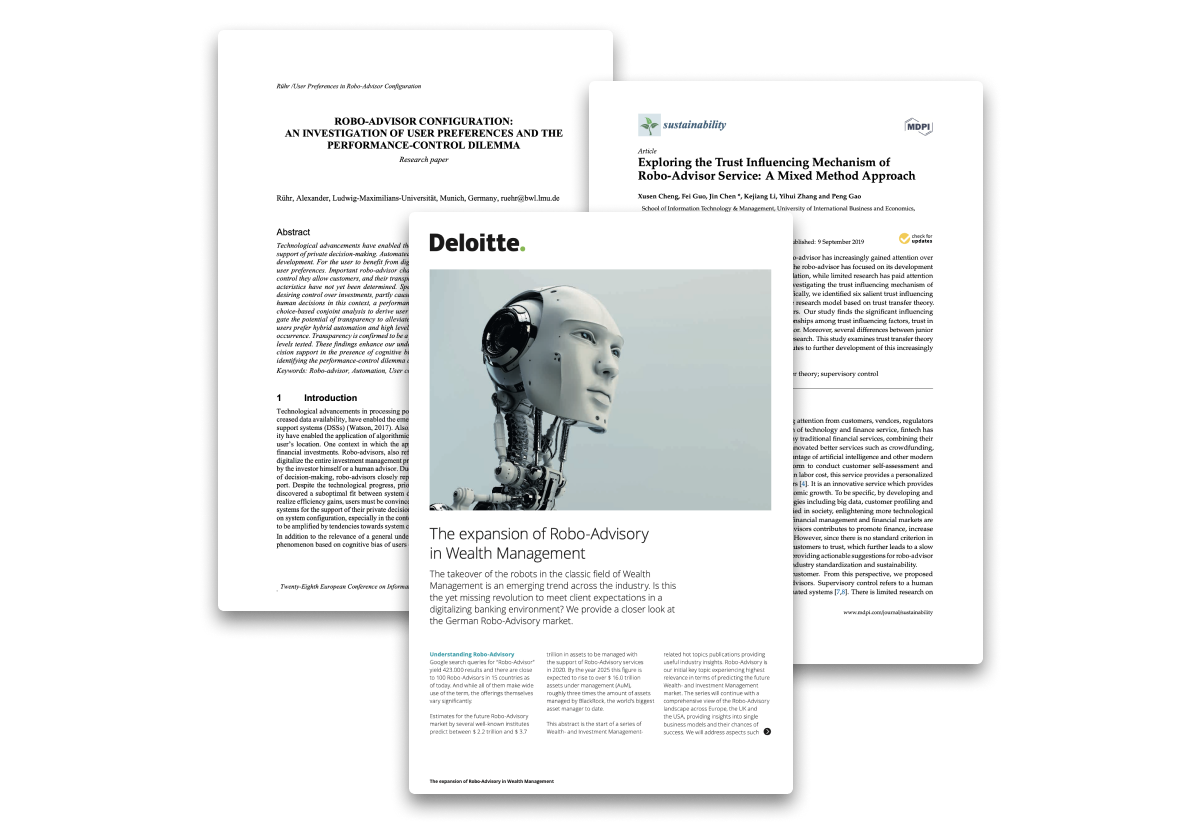
Research studies from the problem discovery phase.
Developed user personas and synthesised points of friction
Now with an understanding of who our users are, informed by publicly available user research studies, I structured those ideas into some loose personas, comprising of ‘junior investors’ (0-2 years investment experience) and ‘senior investors’ (2+ years of investment experience).
These high level personas allowed me to be conscious of the user's needs and goals throughout the design process.
More crucially, through the research conducted I was able to discover common points of friction and pain customers are currently experiencing. Based on this I was able to understand and document these pain points agnostic to building any solution.
These high level personas allowed me to be conscious of the user's needs and goals throughout the design process.
More crucially, through the research conducted I was able to discover common points of friction and pain customers are currently experiencing. Based on this I was able to understand and document these pain points agnostic to building any solution.

Loose personas
Generated user problems and goals
After identifying common pain points found in investors' robo-advising experiences, I could generate a respective list of problems and goals based on each pain point.
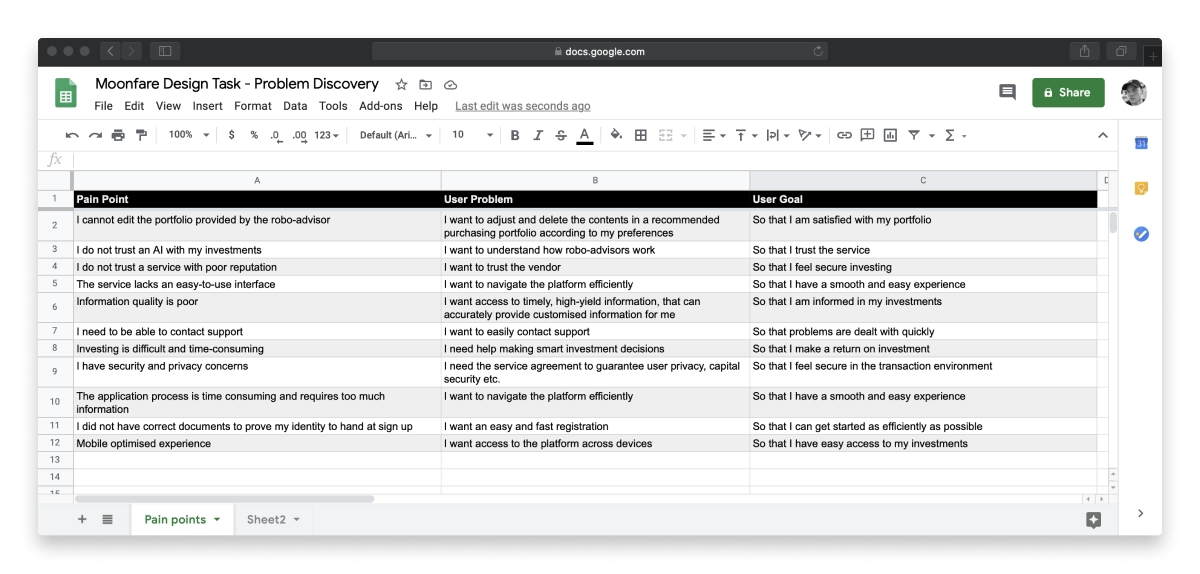
Loose personas
Product strategy
Devised strategy
I began to explore what the company could build to fulfill the customer's needs defined in the previous step.
Type of Robo-Advisor
Which approach will serve customers and build trust?
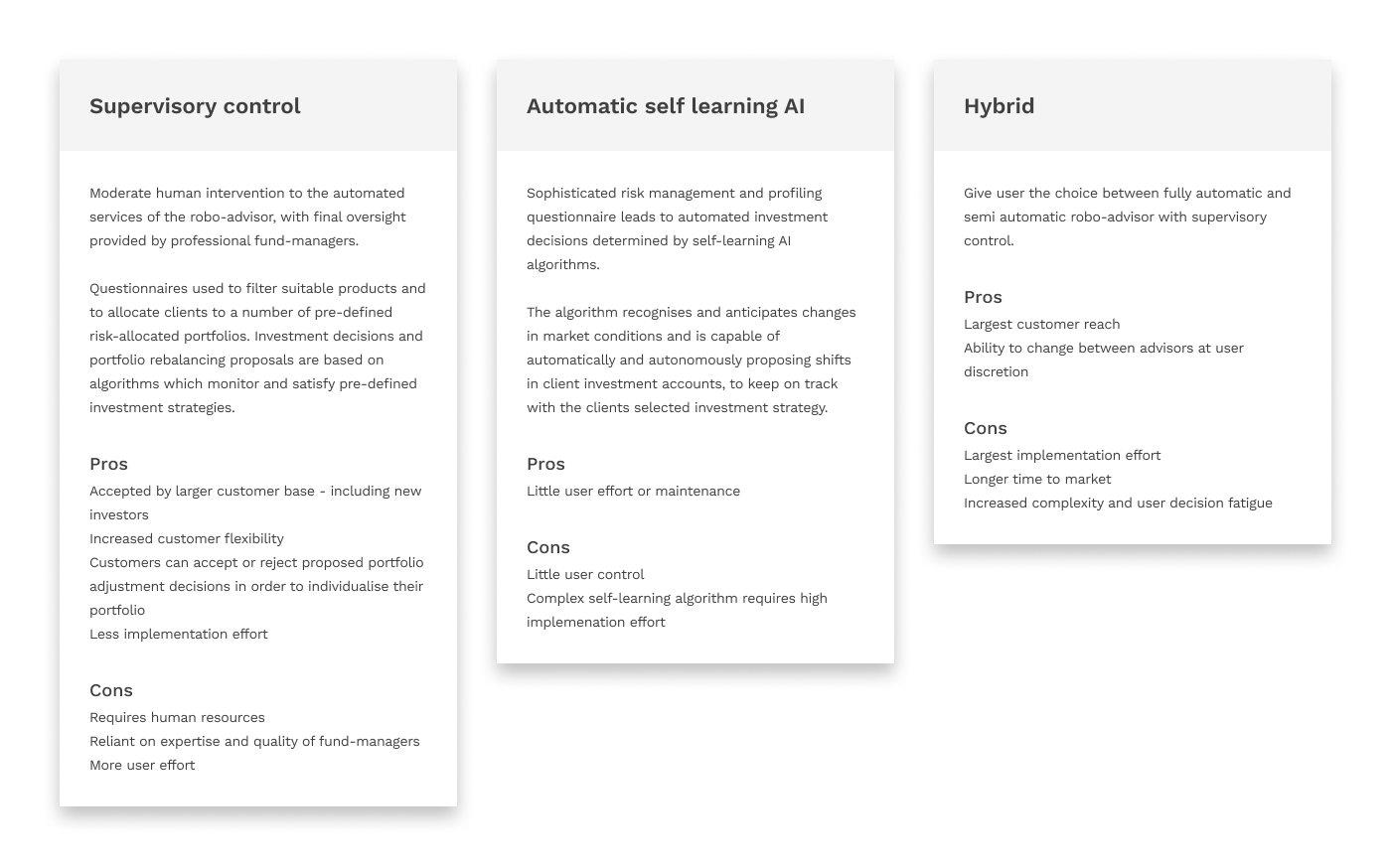
Pros & cons of various robo-advisor approaches
Platform
On what platform should this product be built?
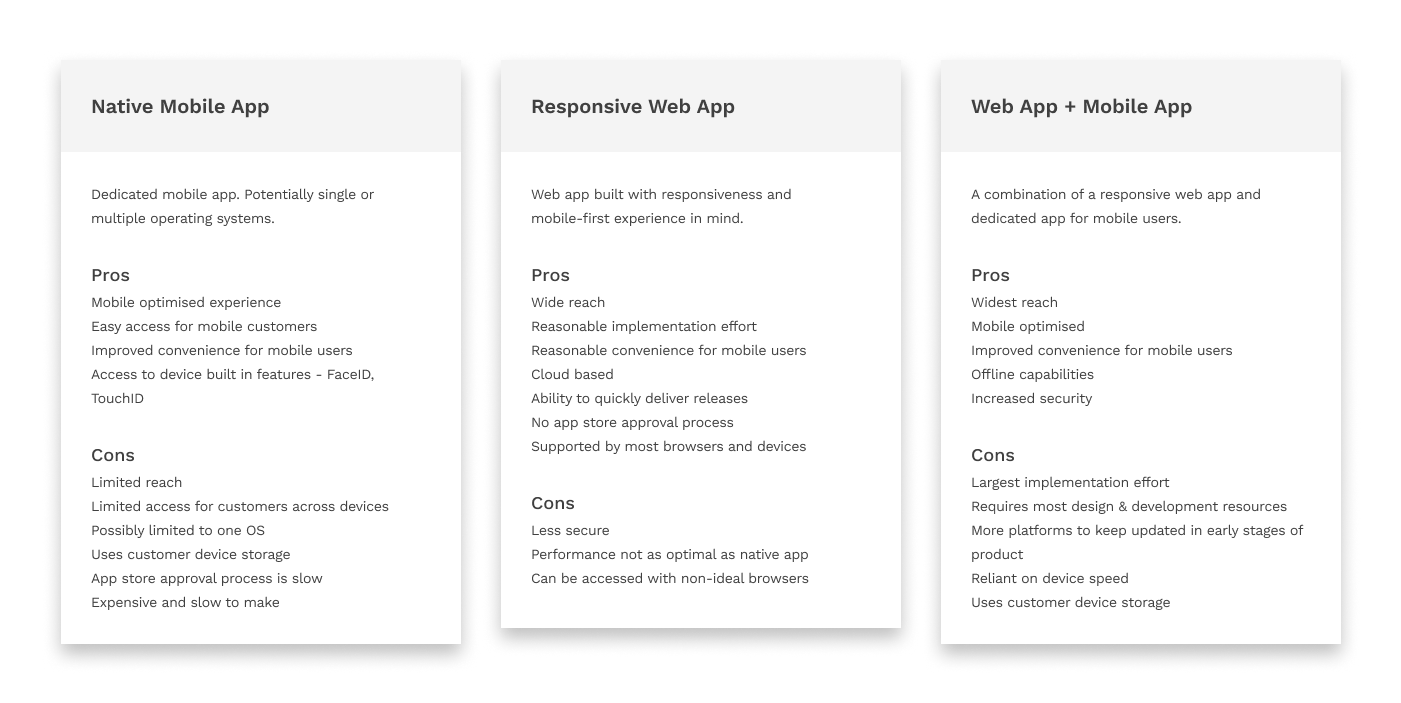
Pros & cons of platform approaches
Business / Brand
Who should release this product?
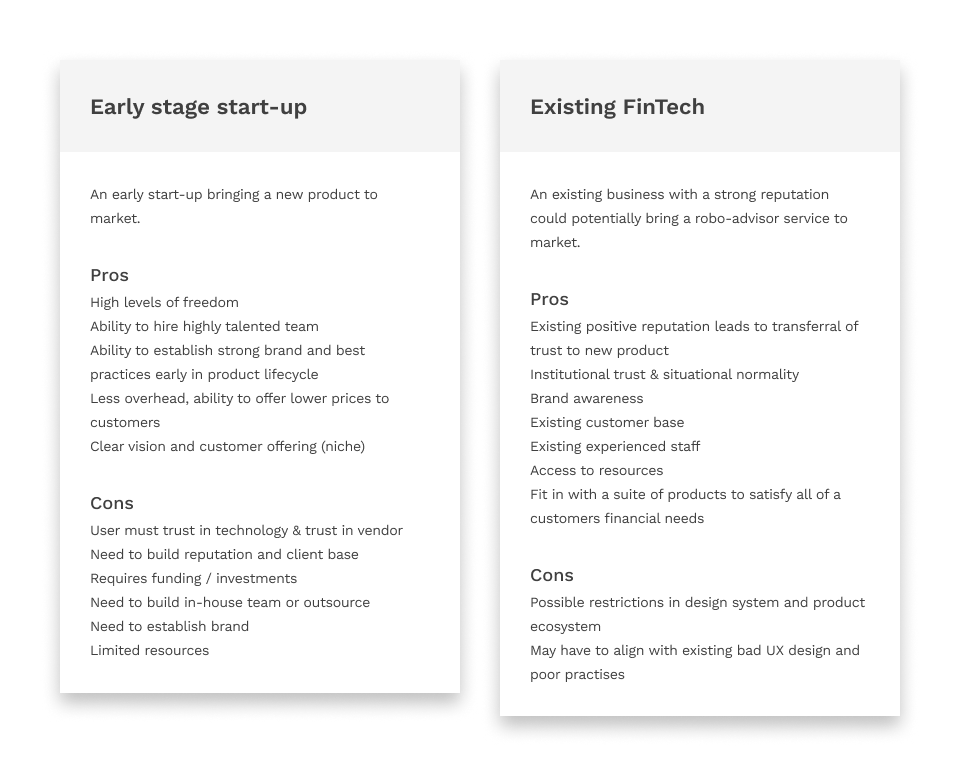
Pros & cons of a start-up and established business
'Final' strategy
Establishing a strong trust in vendor and trust in technology will be essential to building customer trust in the AI capabilities of advanced robo-advisors.
Considering the infancy of the technology and the current attitude towards AI within the general public, an established business could be successful in this space. Transferral of trust and institutional trust would be a significant influential factor here.
User research found that the inclusion of supervisory control in the form of moderate human intervention had a significant influence in user's trust in robo-advisor technologies.
A responsive web app (as opposed to a dedicated mobile app) could provide a more flexible and iterative approach to the product life-cycle, have a wider reach and a reasonable implementation effort.
Considering the infancy of the technology and the current attitude towards AI within the general public, an established business could be successful in this space. Transferral of trust and institutional trust would be a significant influential factor here.
User research found that the inclusion of supervisory control in the form of moderate human intervention had a significant influence in user's trust in robo-advisor technologies.
A responsive web app (as opposed to a dedicated mobile app) could provide a more flexible and iterative approach to the product life-cycle, have a wider reach and a reasonable implementation effort.
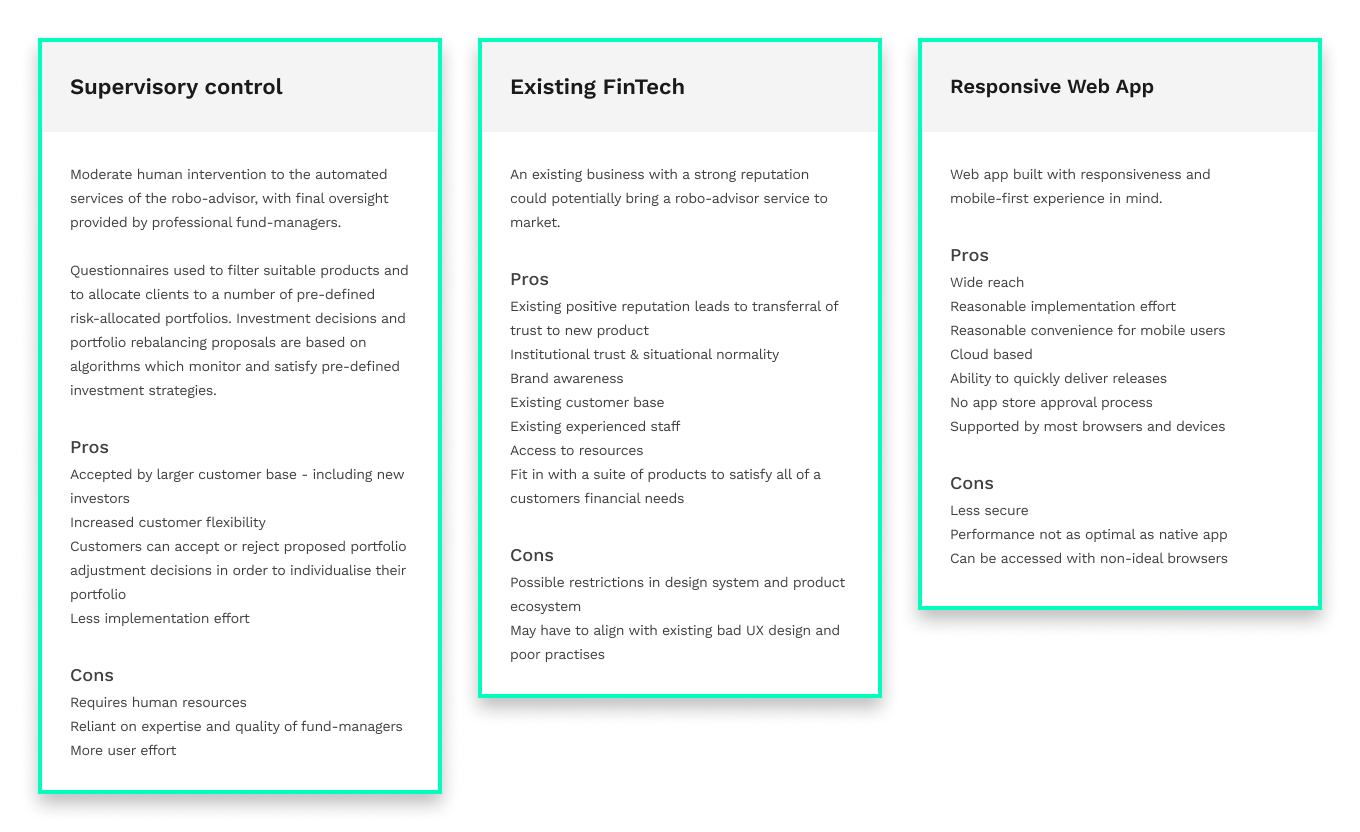
Solution design
Researched market best practices and gathered reference material
After thoroughly understanding and defining a set of user problems and their respective goals, I could start looking at potential ways to solve the problem based on existing market leaders and other closely related material.
Of particular note when considering onboarding; the basis of the framework was informed by and built upon the Nielsen Norman Group's ‘pyramid of trust’. The sequence of steps in the flow was designed to directly address each step of this pyramid.
Of particular note when considering onboarding; the basis of the framework was informed by and built upon the Nielsen Norman Group's ‘pyramid of trust’. The sequence of steps in the flow was designed to directly address each step of this pyramid.
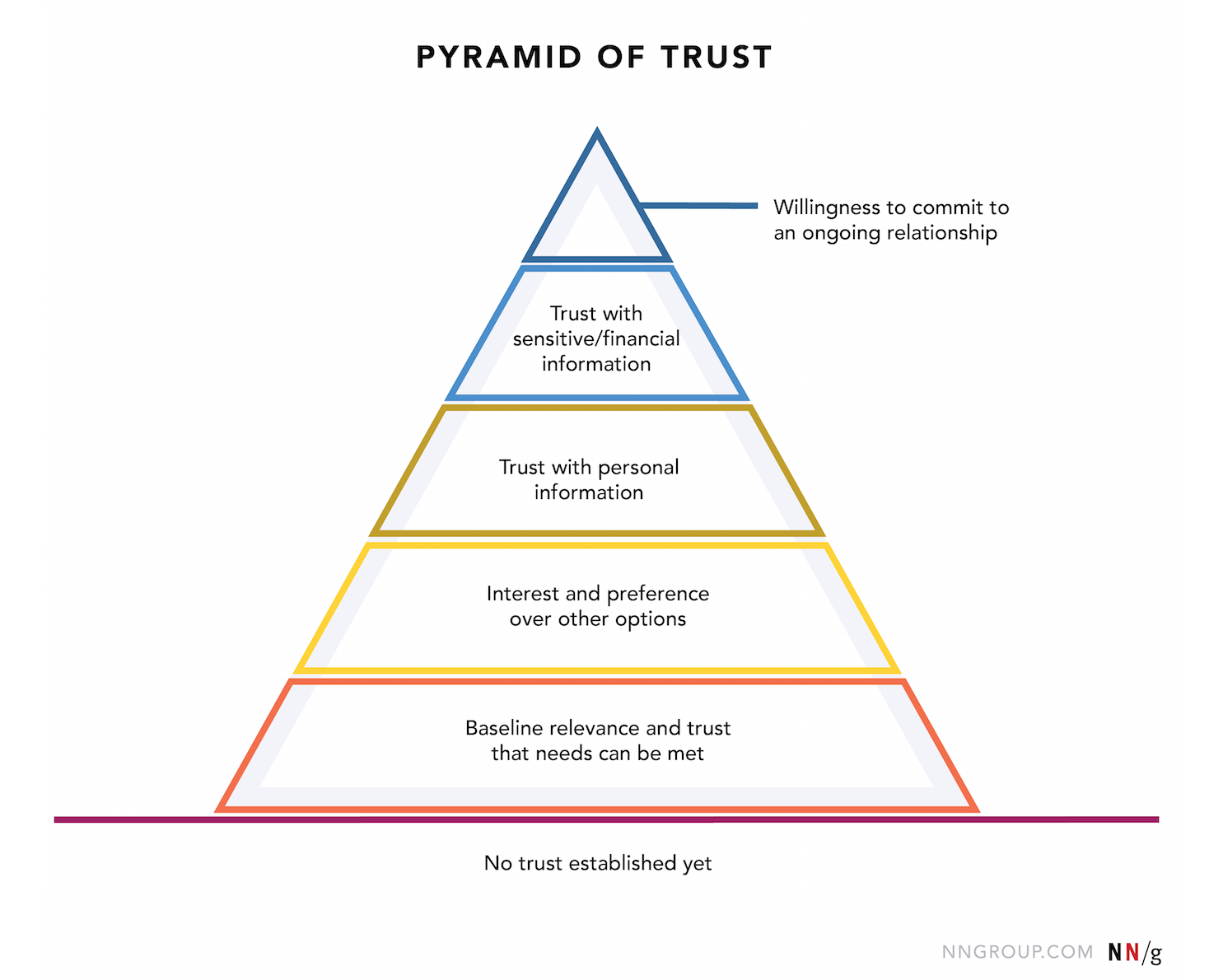
Ideated potential solutions
Armed with my results from the problem discovery phase and findings from the initial step of the solution discovery phase, I began to think in component-level detail by sketching out multiple iterations from a wide scope of potential solutions.
Later in this step I intermittently jumped into Figma to wireframe and rapid prototype some of the promising solutions to obtain a better understanding of their feasibility within a slightly higher fidelity.
Later in this step I intermittently jumped into Figma to wireframe and rapid prototype some of the promising solutions to obtain a better understanding of their feasibility within a slightly higher fidelity.
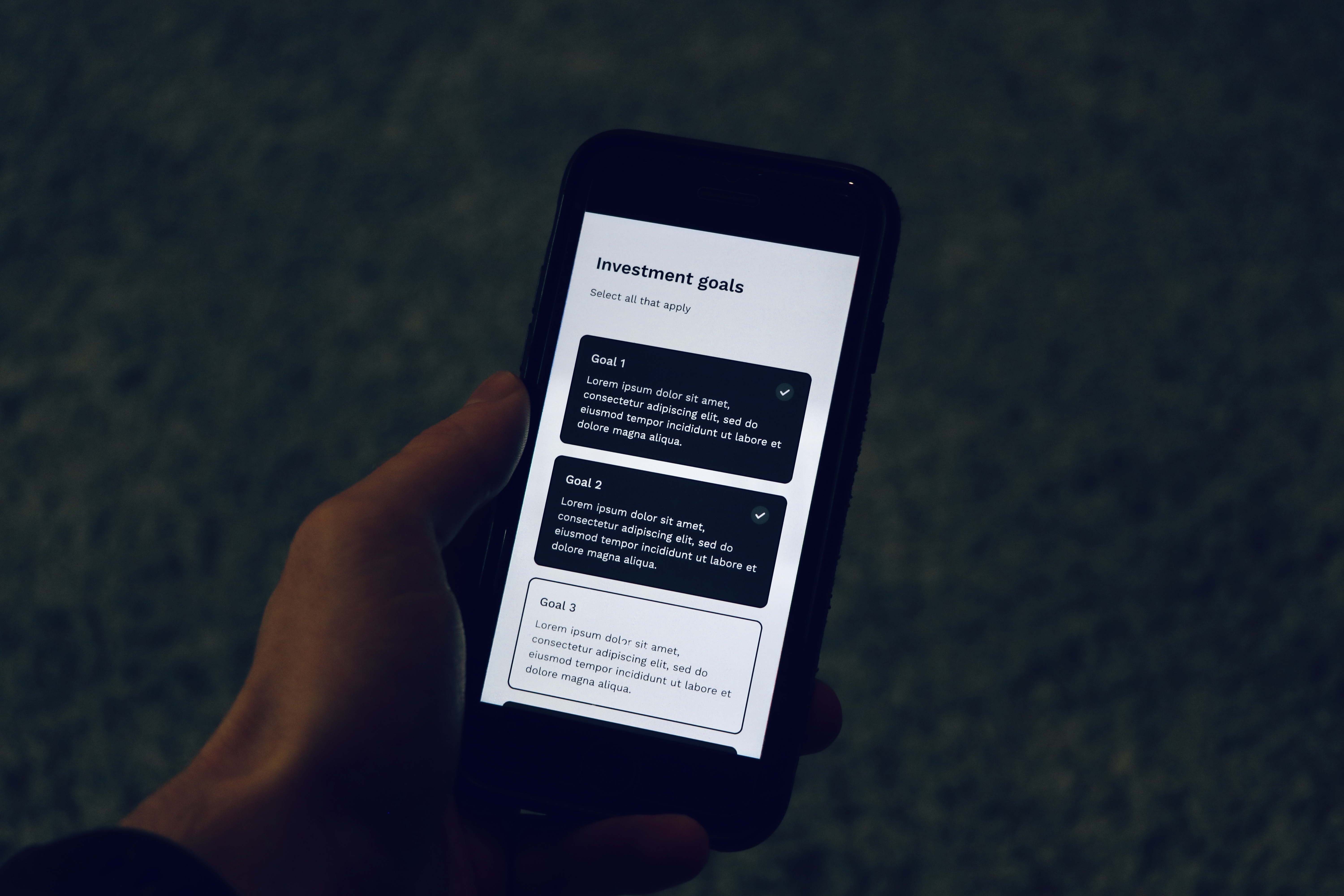
Rapid prototyping of early onboarding wireframes
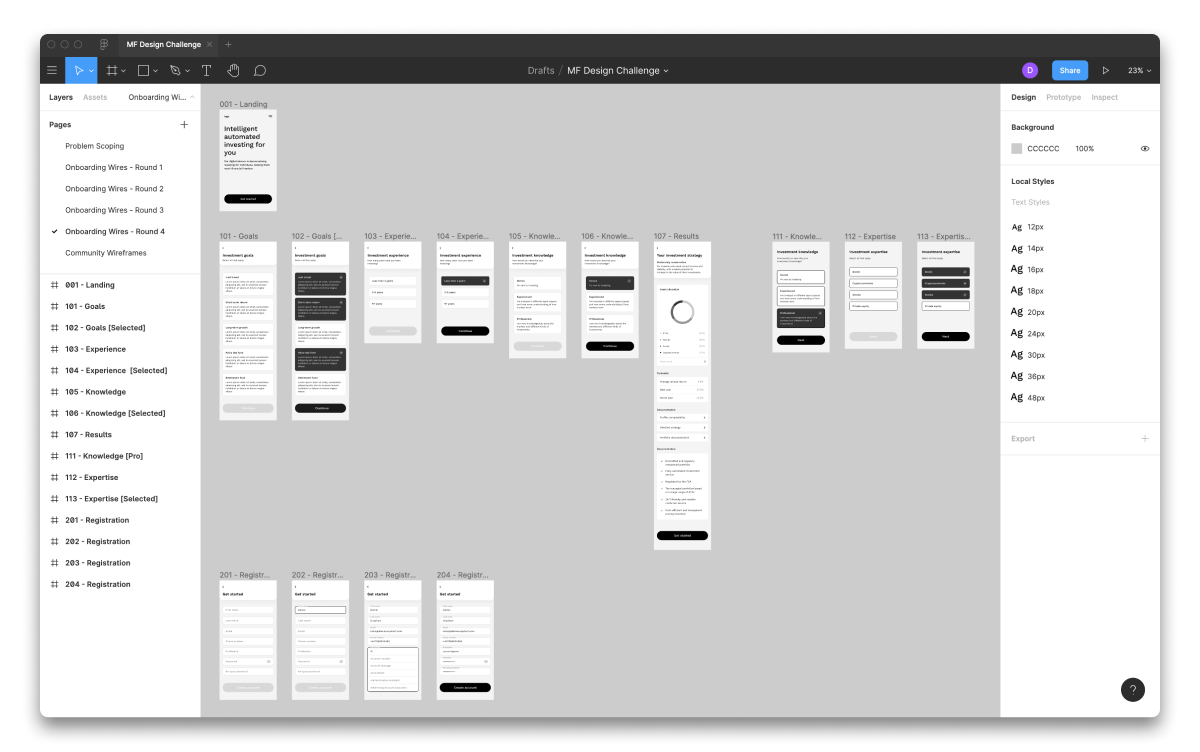
‘Final' onboarding wireframes in Figma
Examined all solutions against criteria
In order to identify and choose the “best” solution to move forward with, I examined each potential solution against a set of baseline criteria, which I have outlined below.
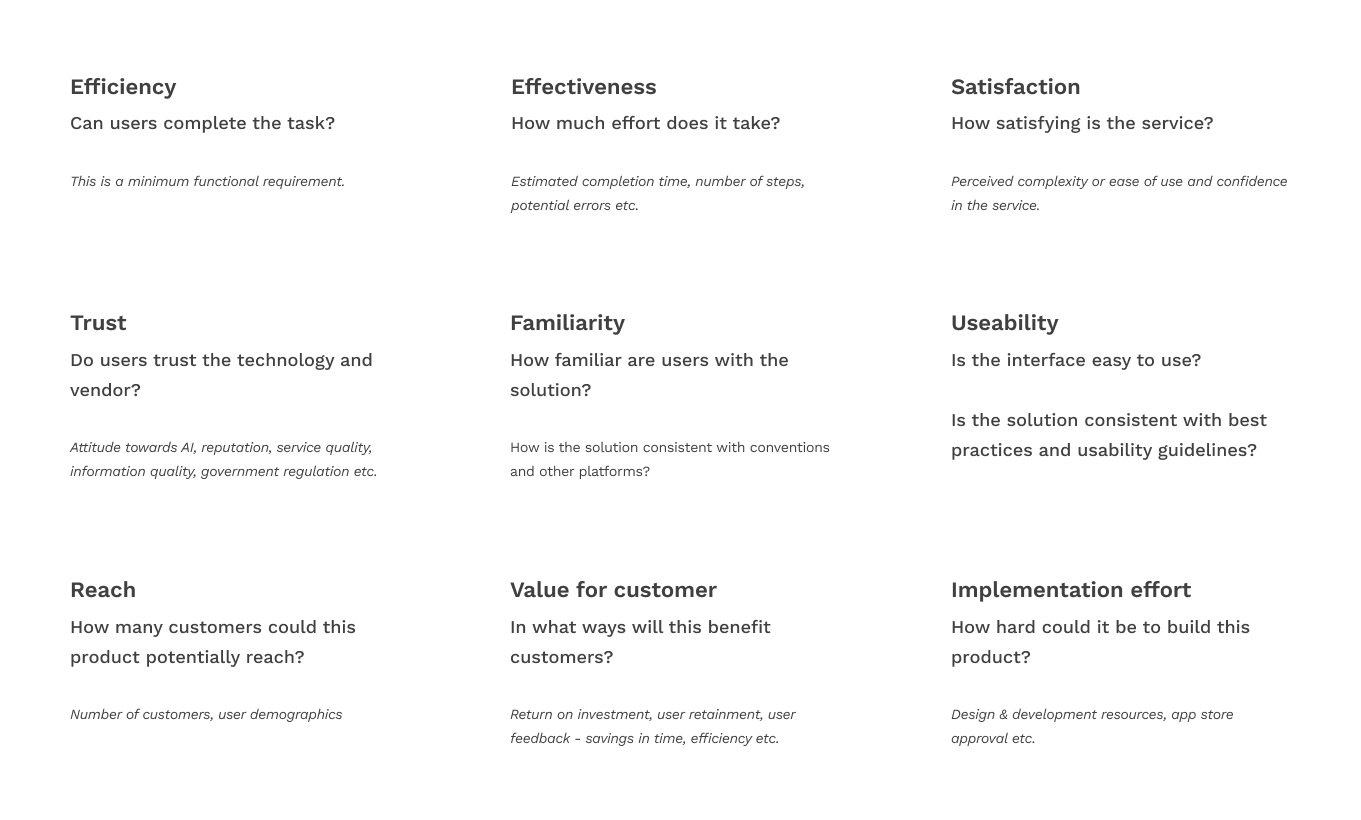
High Fidelity Screens
Landing page
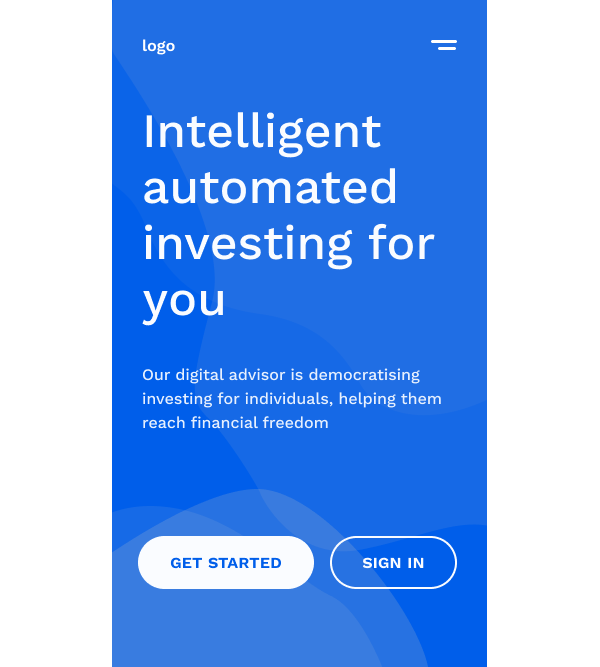
Onboarding: Investment goals
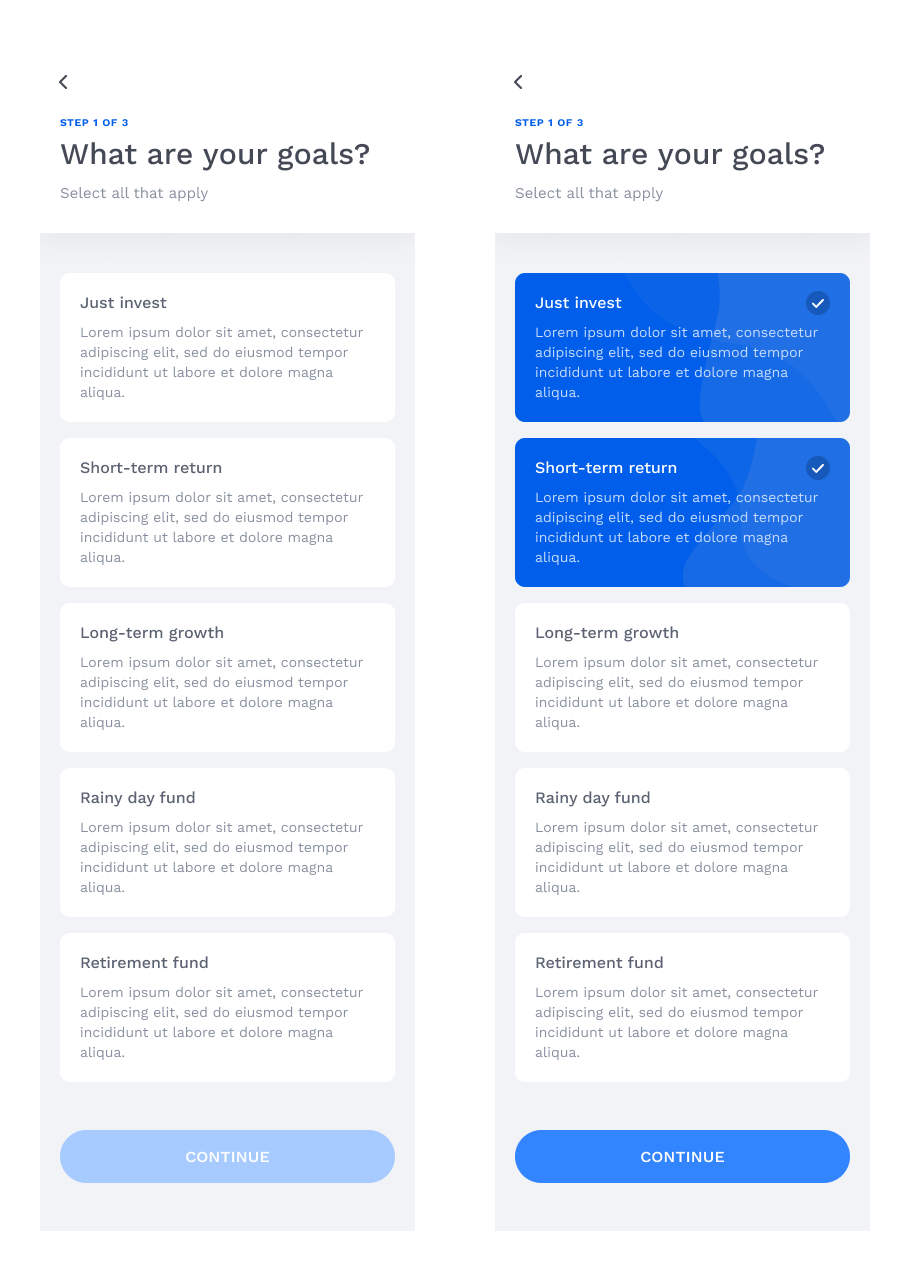
Onboarding results: Investment strategy

Community
How might we build an engaged community of users around this product?
In consideration of building an engaged community around this product, I have considered three approaches:
A community forum (in-product), events (in-person & remote), and in-product referrals.
A community forum (in-product), events (in-person & remote), and in-product referrals.

Wireframed a possible solution
Of the three approaches, both a forum and events may have a positive effect to building an engaged community. Referrals may benefit growth between individuals, but will not have the same impact on larger groups.
Possible features of a forum include:
• Personalisation: Self learning algorithms that recommend tailored topics or articles
• Topics & communities
• Suggested feature improvements
• The ability to post and comment on posts to engage users in discussions
Possible features of a forum include:
• Personalisation: Self learning algorithms that recommend tailored topics or articles
• Topics & communities
• Suggested feature improvements
• The ability to post and comment on posts to engage users in discussions
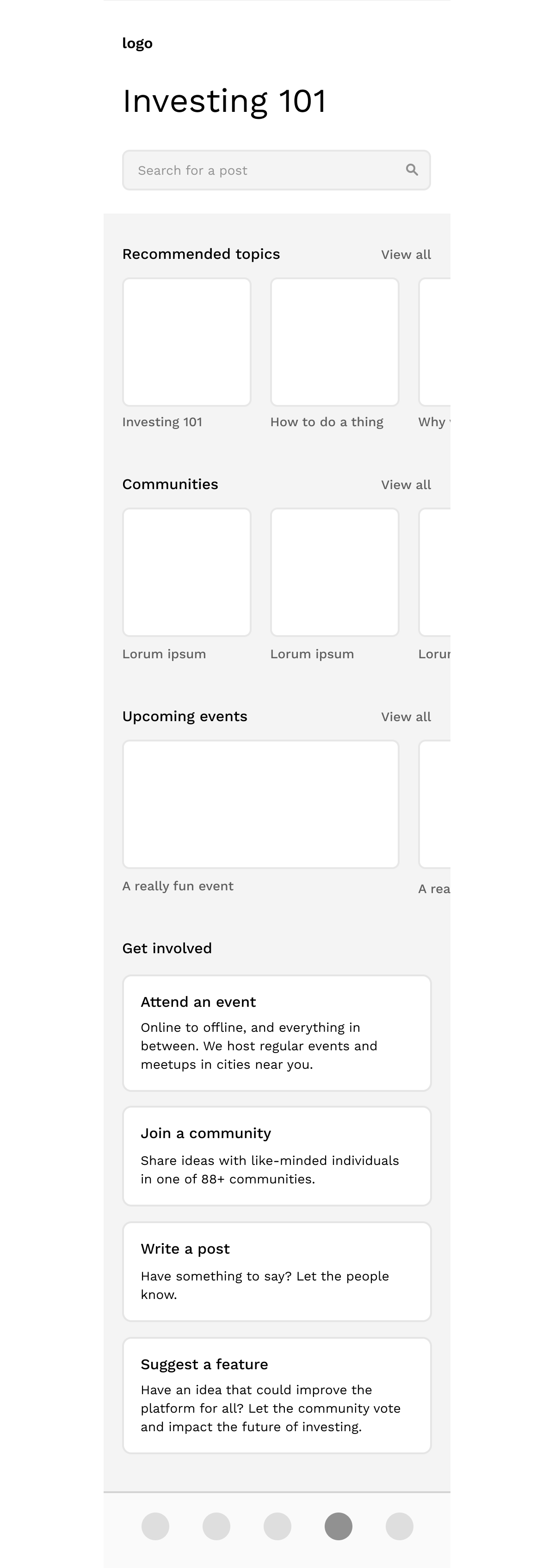
Early wireframe for an in-app community
Final thoughts
Throughout the process I made assumptions that I considered true but within the context and scope of the project they were not tested. With more time, I’d look to validate some of assumptions and hypotheses. This would likely take the form of user testing.
Because establishing trust with users first-try is so important, performing user testing early with a low fidelity prototype rather than later with a market-ready product would be critical to developing an optimal solution that’s effective and safe based on validated assumptions.
I put my possible low-fidelity solutions through the baseline criteria. Ultimately, this was a huge assumption because I was testing my own designs against my own opinions.
I do not believe that the final solution fully realises and solves the user problems, nor does it meet all of the user goals or all of the baseline success criteria I outlined above.
Specifically absent from the solution include the pain points "I want to easily contact support", 'I want to adjust and delete the contents in a recommended purchasing portfolio according to my preferences" although the latter is implied in the 'what you get' features section and could be implemented after account creation.
The bulk of my time was spent in problem and solution discovery. A small proportion of my time was spent considering how an engaged community could be built around this product. These ideas were based on assumptions and not informed by research studies or user insights and thus are unvalidated ideas.
Ideally I would have spent additional time on interaction and visual design. Some areas that would need further development include:
• Building strong design foundations and establishing a consistent design system
• Finding a better balance between effective and beautiful colour
• Improved hierarchy
• Improved and consistent iconography
• Improving copy & establishing an appropriate tone of voice
• Branding
The interface would need to be tested for accessibility and usability and adhere to guidelines such as WCAG 2 colour contrast.
Due to the time restraints, designs were limited to a mobile breakpoint. To further expand on this I would need to explore designs at multiple breakpoints.
Further qualitative and quantitative user research methods would be critical to the success of this product as it developed.
Because establishing trust with users first-try is so important, performing user testing early with a low fidelity prototype rather than later with a market-ready product would be critical to developing an optimal solution that’s effective and safe based on validated assumptions.
I put my possible low-fidelity solutions through the baseline criteria. Ultimately, this was a huge assumption because I was testing my own designs against my own opinions.
I do not believe that the final solution fully realises and solves the user problems, nor does it meet all of the user goals or all of the baseline success criteria I outlined above.
Specifically absent from the solution include the pain points "I want to easily contact support", 'I want to adjust and delete the contents in a recommended purchasing portfolio according to my preferences" although the latter is implied in the 'what you get' features section and could be implemented after account creation.
The bulk of my time was spent in problem and solution discovery. A small proportion of my time was spent considering how an engaged community could be built around this product. These ideas were based on assumptions and not informed by research studies or user insights and thus are unvalidated ideas.
Ideally I would have spent additional time on interaction and visual design. Some areas that would need further development include:
• Building strong design foundations and establishing a consistent design system
• Finding a better balance between effective and beautiful colour
• Improved hierarchy
• Improved and consistent iconography
• Improving copy & establishing an appropriate tone of voice
• Branding
The interface would need to be tested for accessibility and usability and adhere to guidelines such as WCAG 2 colour contrast.
Due to the time restraints, designs were limited to a mobile breakpoint. To further expand on this I would need to explore designs at multiple breakpoints.
Further qualitative and quantitative user research methods would be critical to the success of this product as it developed.